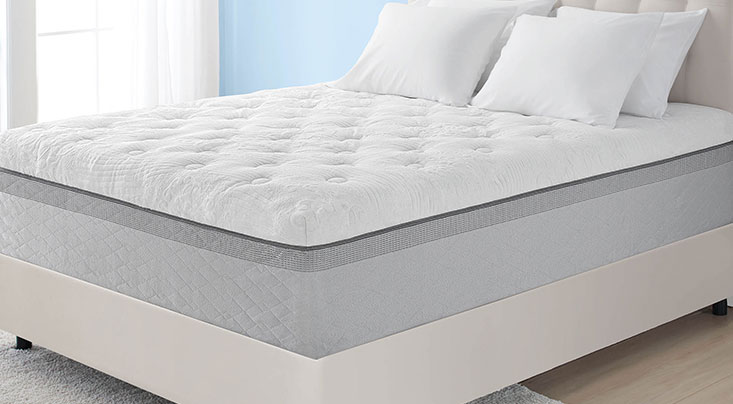When it comes to choosing a new mattress, there are a lot of factors to consider. One of the biggest decisions you'll have to make is whether to go with an all foam mattress or an innerspring mattress. Both types have their own unique benefits and drawbacks, so it's important to understand the differences between them before making a decision. In this article, we'll compare and contrast these two popular mattress types to help you determine which one is the best fit for your needs.All Foam Mattress vs Innerspring: Which One is Right for You?
An all foam mattress, also known as a memory foam mattress, is made entirely of different types of foam. The most common type of foam used in these mattresses is memory foam, which is known for its ability to conform to your body and provide excellent pressure relief. Other types of foam that may be used in all foam mattresses include latex foam and gel foam, each with their own unique benefits. Pros: One of the biggest advantages of an all foam mattress is its ability to contour to your body, providing personalized support and comfort. This can be especially beneficial for those with back pain or joint issues. Foam mattresses are also known for their motion isolation, meaning that movement on one side of the bed is less likely to disturb your partner on the other side. Cons: While foam mattresses provide excellent support, they may not be as bouncy as innerspring mattresses, which can be a downside for those who prefer a more traditional feel. Additionally, foam mattresses may retain heat, making them less ideal for hot sleepers.All Foam Mattress
Innerspring mattresses, also known as coil mattresses, are made with a support system of metal coils or springs, topped with layers of padding and foam. These mattresses have been around for a long time and are still the most popular type of mattress on the market. Pros: Innerspring mattresses are known for their bounce and responsiveness, making them a good choice for those who like a more traditional feel. They also tend to sleep cooler than foam mattresses, which can be a major advantage for hot sleepers. Cons: One of the biggest downsides of innerspring mattresses is their lack of motion isolation. This means that movement on one side of the bed can transfer to the other side, which can be disruptive for couples. In addition, innerspring mattresses may not provide as much pressure relief as foam mattresses, which can be a concern for those with back pain or joint issues.Innerspring Mattress
When it comes to determining which type of mattress is better, it ultimately comes down to personal preference. Both foam and innerspring mattresses have their own unique benefits and drawbacks, so it's important to consider your individual needs and preferences before making a decision.Foam vs Innerspring: Which One is Better?
If you've decided that an all foam mattress is the right choice for you, there are still some additional factors to consider. Not all foams are created equal, and different types of foam can have different effects on your comfort and sleep quality. Let's take a closer look at the three main types of foam used in all foam mattresses: memory foam, latex foam, and gel foam. Memory Foam: Memory foam is known for its ability to contour to your body, providing customized support and pressure relief. It's also highly durable and can last for years without losing its shape. Latex Foam: Latex foam is a natural foam made from the sap of rubber trees. It's known for its responsiveness and bounce, making it a good choice for those who prefer a more traditional feel. Latex foam is also hypoallergenic and resistant to dust mites. Gel Foam: Gel foam has become increasingly popular in recent years for its ability to regulate temperature and provide a cooler sleep experience. It's typically made with a combination of memory foam and gel beads, which help to dissipate heat and keep you comfortable throughout the night.Foam Mattress Comparison: Memory Foam vs Latex Foam vs Gel Foam
When it comes to innerspring mattresses, there are two main types of coils used in their construction: traditional springs and coils. Let's take a look at the differences between these two types of coils. Traditional Spring: Traditional springs, also known as Bonnell coils, are the oldest and most basic type of coils used in mattresses. They are hourglass-shaped and connected with wires, providing a bouncy and supportive feel. Coil: Coils, also known as pocketed coils, are individually wrapped in fabric and operate independently from each other. This allows for better motion isolation and targeted support for different areas of the body.Innerspring Mattress Comparison: Traditional Spring vs Coil
As the name suggests, a hybrid foam mattress combines both foam and innerspring elements. These mattresses typically have a layer of foam on top for comfort, with pocketed coils in the support system. This combination can provide the benefits of both types of mattresses, such as the contouring and pressure relief of foam and the bounce and responsiveness of innerspring.Hybrid Foam vs Innerspring Mattress
When it comes down to it, the best mattress for you will depend on your individual needs and preferences. If you prefer a mattress with a more traditional feel and bounce, an innerspring mattress may be the way to go. If you have back pain or joint issues, an all foam mattress may provide better support and pressure relief. Ultimately, the best way to determine which type of mattress is right for you is to try them out for yourself. Most mattress companies offer trial periods, so take advantage of that and spend some time sleeping on each type of mattress to see which one feels most comfortable for you. Whether you choose an all foam mattress or an innerspring mattress, the most important thing is to find one that helps you get a good night's sleep. After all, a good mattress is an investment in your health and well-being.Which One is Right for You?
All Foam Mattress vs Innerspring: Which is the Better Choice for a Good Night's Sleep?

Introduction to Mattress Types
 When it comes to designing your dream bedroom, choosing the right
mattress
is crucial. After all, a good night's sleep is essential for our overall health and well-being. With so many options available in the market, it can be overwhelming to decide which
mattress
is the best fit for you. Two popular types of
mattresses
that often come up in discussions are the all foam
mattress
and the innerspring
mattress
. In this article, we will explore the differences between these two
mattress
types and help you make an informed decision for your bedroom.
When it comes to designing your dream bedroom, choosing the right
mattress
is crucial. After all, a good night's sleep is essential for our overall health and well-being. With so many options available in the market, it can be overwhelming to decide which
mattress
is the best fit for you. Two popular types of
mattresses
that often come up in discussions are the all foam
mattress
and the innerspring
mattress
. In this article, we will explore the differences between these two
mattress
types and help you make an informed decision for your bedroom.
All Foam Mattress: The Pros and Cons
 As the name suggests, an all foam
mattress
is made entirely from different types of foam, such as memory foam, latex foam, and polyurethane foam. These
mattresses
are known for providing excellent
comfort
and
support
to the body, as they conform to its shape and help relieve pressure points. This makes them an ideal choice for people with
back pain
or
joint pain
. Additionally, all foam
mattresses
are also great at absorbing motion, making them a good option for couples, as one person's movements won't disturb the other's sleep.
However, all foam
mattresses
may not be suitable for everyone. They tend to retain heat, which can make them uncomfortable for people who tend to sleep hot. They also tend to have a shorter lifespan compared to innerspring
mattresses
, and they can be more expensive.
As the name suggests, an all foam
mattress
is made entirely from different types of foam, such as memory foam, latex foam, and polyurethane foam. These
mattresses
are known for providing excellent
comfort
and
support
to the body, as they conform to its shape and help relieve pressure points. This makes them an ideal choice for people with
back pain
or
joint pain
. Additionally, all foam
mattresses
are also great at absorbing motion, making them a good option for couples, as one person's movements won't disturb the other's sleep.
However, all foam
mattresses
may not be suitable for everyone. They tend to retain heat, which can make them uncomfortable for people who tend to sleep hot. They also tend to have a shorter lifespan compared to innerspring
mattresses
, and they can be more expensive.
Innerspring Mattress: The Pros and Cons
 Innerspring
mattresses
have been around for a long time and are the most traditional type of
mattress
. They are made up of a network of metal coils, which provide
support
to the body. Innerspring
mattresses
are known for their
durability
and
breathability
, making them a good option for people who tend to sleep hot. They also come in a variety of firmness levels, so you can choose the one that best suits your
comfort
needs.
However, innerspring
mattresses
may not be the best option for people with
back pain
or
joint pain
, as they don't offer the same level of pressure relief as all foam
mattresses
. They can also be quite noisy, and the motion transfer can be an issue for couples.
Innerspring
mattresses
have been around for a long time and are the most traditional type of
mattress
. They are made up of a network of metal coils, which provide
support
to the body. Innerspring
mattresses
are known for their
durability
and
breathability
, making them a good option for people who tend to sleep hot. They also come in a variety of firmness levels, so you can choose the one that best suits your
comfort
needs.
However, innerspring
mattresses
may not be the best option for people with
back pain
or
joint pain
, as they don't offer the same level of pressure relief as all foam
mattresses
. They can also be quite noisy, and the motion transfer can be an issue for couples.
Which One Should You Choose?
 Ultimately, the choice between an all foam
mattress
and an innerspring
mattress
comes down to personal preference. Consider your
comfort
needs, budget, and any health concerns you may have before making a decision. It's also essential to try out the
mattress
in person before buying, as a few minutes of lying down in a store can give you a better idea of how it will feel to sleep on it night after night.
In conclusion, both all foam
mattresses
and innerspring
mattresses
have their own set of advantages and disadvantages. It's essential to weigh them carefully and choose the one that suits your individual needs and preferences. After all, a good
mattress
is the key to a good night's sleep.
Ultimately, the choice between an all foam
mattress
and an innerspring
mattress
comes down to personal preference. Consider your
comfort
needs, budget, and any health concerns you may have before making a decision. It's also essential to try out the
mattress
in person before buying, as a few minutes of lying down in a store can give you a better idea of how it will feel to sleep on it night after night.
In conclusion, both all foam
mattresses
and innerspring
mattresses
have their own set of advantages and disadvantages. It's essential to weigh them carefully and choose the one that suits your individual needs and preferences. After all, a good
mattress
is the key to a good night's sleep.



































































